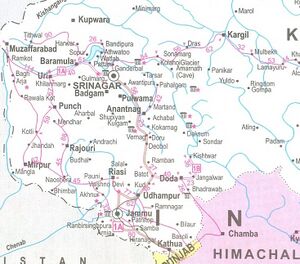Kishan Ganga
| Author:Laxman Burdak, IFS (R) |

Kishan Ganga (किशन गंगा) or Neelum River (नीलम नदी) is a river in the Kashmir region of India and Pakistan. It is called Kishanganga in India and Neelum River in Pakistan.
Variants
- Kishan Ganga (किशन गंगा)
- Kishanganga (किशनगंगा)
- Kishenganga (किशनगंगा)
- Kishanganga River (किशनगंगा नदी)
- Neelam River (नीलम नदी)
- Neelum River (नीलम नदी)
Course
It originates in the north of Indian Jammu and Kashmir, flows through the Neelam District of Pakistan's Azad Kashmir and then merges with the Jhelum River near the city of Muzaffarabad. The Neelam River enters Pakistan from India in the Gurais sector of the Line of Control, and then runs west till it meets the Jhelum north of Muzzafarabad.[1]
The Kishanganga River originates from Krishansar Lake[2] in the vicinity of Sonamarg in the Indian union territory of Jammu and Kashmir, and runs northwards to Badoab village in Tulail Valley where it meets a tributary from the Dras side. Then it runs westwards, parallel to the Kashmir Line of Control. It is fed by many glacial tributary streams on its way. It enters Pakistani self-governing territory of Azad Kashmir in the Gurez sector of the Line of Control. Then it again runs west, parallel to the Line of Control, passing by Sharada. After Sharda, it bends to a southwesterly direction and runs along the Line of Control near Tithwal. Then it bends northwest again, making a wide arc to join the Jhelum River in Muzaffarabad.[3][4]. Recently the Go Gurez campaign has been launched to make people aware of the area.
History
Shardadesh is a name for the drainage basin of the Kishanganga River.
The river has traditionally been known as the Kishanganga River and is still known as such in India; after the partition of India in 1947, the river was renamed the Neelum River in Pakistan in 1956.[5][6][7]
Valleys
The Kishanganga River is 245 kilometres long. It covers 50 kilometers in the Indian-administered Kashmir where it flows through the Tulail Valley and then Gurez Valley. It covers the remaining 195 kilometres in Pakistan-administered Kashmir and flows through the. From its origin it flows through the Neelam Valley.
The Neelum Valley is a Himalayan gorge in the Kashmir region, along which the Neelum River flows. This green and fertile valley is 250 km in length and stretches its way from Muzaffarabad all the way to Athmuqam and beyond to Taobutt. It is one of the most attractive tourists places, like Swat and Chitral, but due to poor road system is yet veiled to the outside world. This area was badly affected by the 2005 earthquake and was cut off from the outside world as the roads and paths were filled with rubble. Now construction of an international standard road is in progress. There are two entrances for Neelum valley, one Neelum Road by Muzaffarabad and the other by Kaghan the Jalkhad Road. Generally Neelum valley starts just after Muzaffarabad but in political division the area from Muzaffarabad to Chelhana is named Kotla valley. District Neelum starts from Chelhana and goes up to Taobutt.
Religious significance
Krishansar Lake and Sharada Peeth are important religious site for Hindus, who undertake the annual pilgrimage to these sites along the Kishanganga River. In the ancient times it was among the prominent centre of learning in the subcontinent in part with Nalanda and Taxila. Sharada script the - native script for the Kashmiri language is named in the honor of main deity of Sharada Peeth. Sharada Peeth is one of the most venerated site for the Kashmiri Pandits. Sharada Peeth temple was damaged in the 2005 Kashmir earthquake. Acting on a petition from Delhi-based Kashmiri Pandit Ravinder Pandita, the Supreme Court of Pakistan ordered the Government to conserve the Sharada Peeth temple and the govt to identify and restore temples and gurudwaras.[8] The "Save Sharada Committee" of concerned Hindus has been demanding the opening of special corridor from India to Sharada Peeth in Pakistan-administered Kashmir for the visits of Hindu pilgrims from India.[9]
External links
References
- ↑ Banerji, Arindam (20 June 2003). "The Neelam Plan". Rediff.
- ↑ Majid Hussain (1998). Geography of Jammu and Kashmir. Rajesh Publications, 1998. p. 13–. ISBN 9788185891163.
- ↑ "The Neelam Plan". Rediff.
- ↑ [1]
- ↑ Lavoy, Peter R. (12 November 2009). Asymmetric Warfare in South Asia: The Causes and Consequences of the Kargil Conflict. Cambridge University Press. p. 56. ISBN 978-1-139-48282-0.
- ↑ Dewan, Parvez (2004). Parvéz Dewân's Jammû, Kashmîr, and Ladâkh: Kashmîr. Manas Publications. p. 277. ISBN 978-81-7049-179-8.
- ↑ Naqvi, Mubashar (28 July 2017). "Charms of the Neelum valley". The Friday Times.
- ↑ For the first time in 72 years, Indian Hindu couple performs puja at Sharada Peeth in PoK, DNA (newspaper).
- ↑ Supreme Court in PoK intervenes to save Sharda temple, DNA (newspaper).
Back to Rivers/Rivers in Jammu and Kashmir/Rivers in Pakistan

